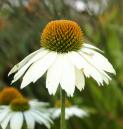Liatris. L. spicata (L.) Willd. Gay-feather. Devil's Bite. Colic Root. Button Snakeroot.—An indigenous perennial composite plant growing in natural meadows and moist grounds from Southern Ontario and Minnesota, southward. It has a tuberous root, and an erect annual stem, which terminates in a spike of beautiful, purple, compound flowers, appearing in August. The root is said by Schoepf to have a terebinthinate odor, and a warm, bitterish, terebinthinate taste; to be possessed of diuretic properties; and to be useful as a local application in gonorrhea and sore throat. The leaves of the allied Trilisa odoratissima, (Walt.) Cass. (Liatris odoratissimus Willd.), or Vanilla leaf, are very largely employed in the Southern United States to flavor tobacco, and to preserve clothing, etc., from moths. As a preservative it is worthless. The agreeable odor is due to coumarin, C9H6O2, which may be frequently noticed in crystals upon the surface of the smooth spatulate leaves. (A. J. P., March, 1875; Sept., 1881; xlvii, 116; N. R., 1882, 66.) The roots of L. scariosa Willd. (Lacinaria scariosa Hill) and L. squarrosa Willd. (Lacinaria squarrosa Hill) (rattlesnake's master) have been employed to cure the bite of the rattlesnake. According to Wm. P. C. Barton, all the tuberous-rooted species of Liatris are active diuretics.

Henriette's Herbal Homepage
Welcome to the bark side.
Henriette's herbal is one of the oldest and largest herbal medicine sites on the net. It's been online since 1995, and is run by Henriette Kress, a herbalist in Helsinki, Finland.
